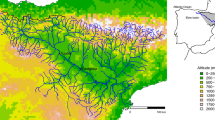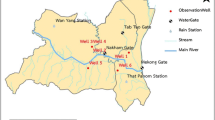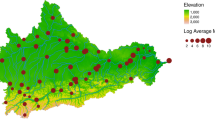Abstract
River level forecasting is a difficult problem. Complex river dynamics lead to level series with strong time-varying serial correlation and nonlinear relations with influential factors. The current high-frequency level series present a new challenge: they are measured hourly or at finer time scales, but predictions of up to several days ahead are still needed. In this framework, prediction models must be able to provide h-step predictions for high h values. This work presents a new nonlinear model, double switching regression with ARMA errors, that addresses the features of level series. It distinguishes different regimes both in the regression and in the error terms of the model to capture time-varying correlations and nonlinear relations between response and predictors. The use of different regression and ARMA regimes will provide good h-step prediction for both low and high h values. We also propose a new estimation method that, in contrast to other switching models, does not need to define the regimes before estimating the model. This method is based on a two-step estimation and model-based recursive partitioning. The approach is applied to model the hourly levels of the Ebro River in Zaragoza (Spain), using as input an upstream location, Tudela. Using the fitted model, we obtain hourly predictions and confidence intervals up to three days ahead, with very good results. The model outperforms previous approaches, especially with high values and in cases of long-term predictions.



Similar content being viewed by others
Data Availability
Data cannot be made freely available due to restrictions by data provider, Confederación Hidrográfica del Ebro.
References
Aguilar JV, Langarita P, Linares L, Gómez M, Rodellar J (2013) An adaptive predictive approach for river level forecasting. J Hydroinformatics 15(2):232–245
Amiri E (2015) Forecasting daily river flows using nonlinear time series models. J Hydrol 527:1054–1072
Breiman L (2001) Random forests. Mach Learn 45(1):5–32
Brockwell PJ, Davis RA (2006) Introduction to time series and forecasting. Springer, Berlin
Cebrián AC, Abaurrea J, Asín J, Segarra E (2019) Dynamic regression model for hourly river level forecasting under risk situations: an application to the Ebro river. Wat Res Manag 33:523–37
Ferraris L, Rudari R, Siccardi F (2002) The uncertainty in the prediction of flash floods in the northern mediterranean environment. J Hydrometeorol 3(6):714–27
Fu JC, Huang HY, Jang JH, Huang PH (2019) River stage forecasting using multiple additive regression trees. Wat Res Manag 33:4491–507
Ghorbani MA, Deo R, Khosrowshahi V, Yaseen Z, Terzi O (2017) Implementation of a hybrid mlp-ffa model for water level prediction of Lake Egirdir, Turkey. SERRA: 1–15
Hayashi F (2011) Econometrics. Princeton University Press, Princeton
Hubrich K, Terasvirta T (2013) Thresholds and smooth transitions in vector autoregressive models. Adv Econ 32:273–326
Pedregal D, Rivas R, Feliu V, Sánchez L, Linares A (2009) A non-linear forecasting system for the Ebro river at Zaragoza. Spain Environ Model Softw 24(4):502–509
Poul A, Shourian M, Ebrahimi H (2019) A comparative study of mlr, knn, ann and anfis models with wavelet transform in monthly stream flow prediction. Wat Res Manage 33:2907–23
Tong H, Thanoon B, Gudmundsson G (1985) Threshold time series modeling of two icelandic riverflow systems. JAWRA 21(4):651–662
Vasas K, Elek P, Márkus L (2007) A two-state regime switching autoregressive model with an application to river flow analysis. J Stat Plan Inference 137 (10):3113–3126
Yaseen Z, Naganna S, Sa’adi Z, Samui P, Ghorbani MA, Salih S, Shahid S (2020) Hourly river flow forecasting: application of emotional neural network versus multiple machine learning paradigms. Wat Res Manag 34:1075–91
Zeileis A, Hothorn T, Hornik K (2008) Model-based recursive partitioning. J Comput Graph Stat 17(2):492–514
Acknowledgements
A.C. Cebrián is member of the project MTM2017-83812-P, and the research group Modelos Estocásticos supported by Gobierno de Aragón.
Funding
No funding was received for conducting this study.
Author information
Authors and Affiliations
Contributions
AC was a major contributor to the initial study conception and design. Data preparation and analysis were performed by RS and AC. The first draft of the manuscript was written by AC and all authors commented on previous versions of the manuscript. All authors read and approved the final manuscript.
Corresponding author
Ethics declarations
Conflict of interests
The authors have no conflicts of interest to declare that are relevant to the content of this article.
Additional information
Publisher’s Note
Springer Nature remains neutral with regard to jurisdictional claims in published maps and institutional affiliations.
Rights and permissions
About this article
Cite this article
Cebrián, A.C., Salillas, R. Forecasting High-Frequency River Level Series Using Double Switching Regression with ARMA Errors. Water Resour Manage 35, 299–313 (2021). https://doi.org/10.1007/s11269-020-02733-y
Received:
Accepted:
Published:
Issue Date:
DOI: https://doi.org/10.1007/s11269-020-02733-y




